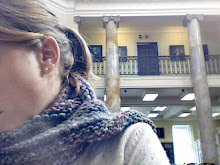
Going off the grid
On Thursday I begin my trip to the Upper Peninsula of Michigan. It should take about 27 hours – give or take a few – from Andover to Jacobsville, MI. Fortunately, I have the new Harry Potter on audiotape and so I’ll make it to the real bowels of the Midwest before I’m without driving entertainment (save for arlo’s continuous snoring). I’ll be borrowing a place on the shores of Lake Superior for the foreseeable future…or until I want to poke my eyes out because of insufferable loneliness. I hope to make it a month or so. It’s my mother’s boyfriend’s place and he’s been kind enough to let this poor dissertation writer retreat from the world. His description – which cracked me up – is below. Perhaps I'll befriend Harry...
I’ll be officially off the grid – no easy phone, no internet, no wires, no cables, no mass communication distractions. I figure that if I can’t be productive with absolutely no interference, I might as well hang up my macbook and retreat into the woods for good. In hopes of preserving some sanity, I plan to drive into town (40 minutes away) a couple times a week to check email and have meaningful interpersonal communications with the grocery store clerks and the gas station attendants. If you happen to be in the area, don't hesitate to stop by and say hello...
So here's the scoop:
"1. The property sits on a bluff overlooking Lake Superior's Keweenaw Bay. Across the 7-mile-wide bay is the Abbaye Peninisula (the tip of which I find one of the U.P.'s most delightful spots on a sunny, not-too-windy day). Beyond the thin green strip of the Abbaye Peninsula is another bay you can't see, and beyond that you see the Huron Mountains 25 miles away. A little to the south of them, you can see Mt. Arvon, Michigan's highest point. Looking south across the bay you can make out Pequaming, where Henry Ford built a summer house and taught locals traditional English dances on his front porch. On a clear day you can see all the way to the smokestack of the Celotex plant in L'Anse at the bottom of the bay. Looking north you can see what locals call "Rabbit Island" (Traverse Island on maps) because of that animal's abundance there. The island is directly east of the hamlet Rabbit Bay. Beyond the island you see the open water of Lake Superior, which is about 1,200 feet deep in places. A 140-mile boat ride beyond the island will take you to remote Wah Wah, Ontario.
2. Our property extends 600 feet along the bluff, from the outhouse to the south to a giant white pine to the north (where Red Rock Road turns due north). The bluff is high enough to be quite dangerous. Don't stand too close to the edge, as parts are undercut and may crumble.
3. There's a cabin on the bluff you may enjoy staying in. Another pleasant place I like to read and sleep is the nook in the dormer on the second floor of the house. It has a sweeping view of the bay and mountains beyond. Late at night you can see the flashing light of the Huron Lighthouse on one of the 3 little islands just east of the tip of the Abbaye Peninsula. North of the cabin is a screened-in porch on the bluff with a good (and safe) viewing platform from which you can look down in the water. Sometimes a pair of loons swim past, diving periodically for fish. Eagles and hawks frequently fly along the coast (we have to keep an eye out for them when Stan goes out because one could easily swoop down and snatch him away).
4. There is no cell phone service in the area.
5. It's been a dry summer. Every other day or so it would be nice if you would water the day lillies next to the sauna, the herbs in the garden on the south side of the house, and the marigolds just south of the garden. Also, Harry would probably appreciate your watering his several marijuana plants and potato plants next door.
6. If you want to explore the area, there's an historic quarry across the street about a quarter mile down the mown drive past a summer cottage. (See photos on living room wall of it when in operation in the late 19th century). It suppled some of the highest quality red sandstone in the country, used to build many Keweenaw buildings and shipped as far as NYC to build brownstones and the first Waldorf Astoria Hotel. Entering the quarry is tricky, as most of the rim is sheer and deep. If you head left along the rim, you'll find a place you can make it down (it helps to slide slowly on your butt part of the way). The lush environment is a surprising contrast to the barren landscape seen in the old photos when the quarry was in operation. Nature triumphs in the end."






